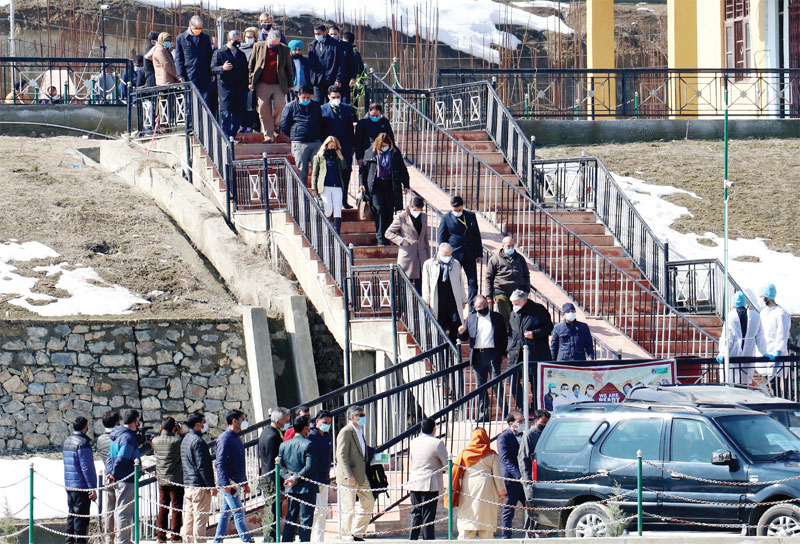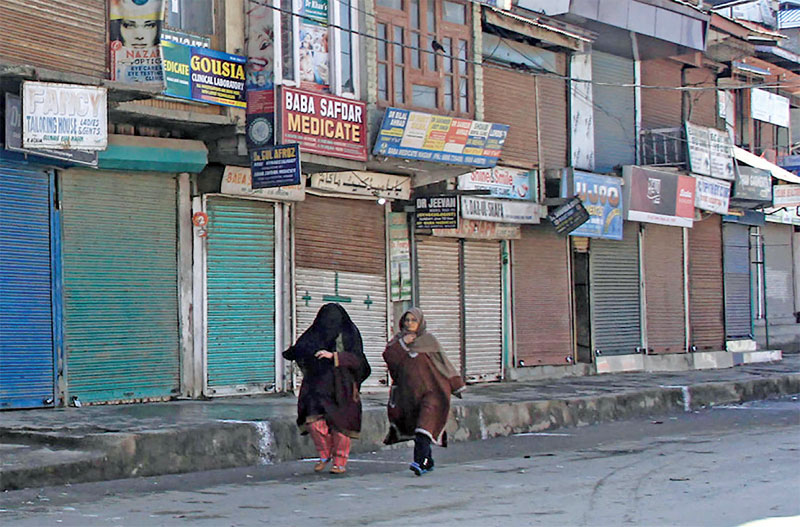The ISI may have lost the plot in its war for Kashmir
 Dr N.C. Asthana
Dr N.C. Asthana
The Inter-Services Intelligence (ISI) committed some fundamental mistakes in its Kashmir operation of supporting, equipping and instigating an insurgency even as it came tantalisingly close to creating a ‘climate of collapse’. It sought to capitalise on the discontent that had been brewing since long.
Discontent has been simmering in Kashmir since decades, and it has manifested in various forms. The ISI sought to exploit the situation by introducing an ‘armed component’ to it in a classic example of ‘export of insurgency’.
By 1989, sporadic violence had started taking the shape of an insurgent movement with increasingly greater involvement of the people. January 26 and August 15 were observed as ‘black days’ for the first time. The state quickly slipped into an ‘era of strikes’ by various sections of the society.
In the first week of February 1990, Pakistan gave the call for a ‘solidarity week’ as a token of moral support. By 1990, subversion had crept into the state administration also. From July, the state government employees struck work on three occasions in support of calls given by the militants. The third strike was in protest over dismissal of five employees for hobnobbing with the militants, and it lasted for 72 days. In the end, the government buckled!
On 5 February 1991, the Pakistan Prime Minister Nawaz Sharif gave the call for a strike and it evoked a very good response in the Valley. In 1992, a bomb was planted in the Police Headquarters (PHQ) itself. That was an example of the subversion in the ranks of the police, as a bomb in the PHQ could not have been planted without inside help. A landmine attack on the route of the then advisor to the governor was also not possible without information regarding his movement having been leaked from the police.
What Pakistan had not been able to do in Operation Gulmarg (1947), and in Operation Gibraltar (1965) from outside, they hoped to accomplish this time from within. One could feel the ‘climate of collapse’ everywhere.

How the ISI armed the insurgency?
Weaponry for terrorists came from, as John K. Cooley (in his Unholy Wars: Afghanistan, America and International Terrorism) and Lawrence Lifschultz of The Guardian reveal, the pilferage from the arms supplied on an unprecedented scale by the CIA in its covert Operation Cyclone during the Mujahideen War (1980-89) for which the ISI was the conduit. In monetary terms, it was not a costly operation. All that the ISI was obliged to spend in cash was for the porters and guides in that pre-GPS era for infiltrating the terrorists.
Training was imparted to terrorists in makeshift camps and it was highly perfunctory. The Daura-e-Aam etc., were essentially indoctrination sessions. To this date, in most of the terrorist attacks, they have displayed very poor tactics and seemed eager only to achieve ‘martyrdom’ at the earliest.
How the ‘insurrectional focus’ faded over time
Pakistan had presumed that their support to insurgency would inflict the classical ‘death by thousand cuts’. Yes, they did inflict the thousand cuts, but India being a large country was able to sustain the losses.
The ISI had thought that the insurrectional focus would trigger a chain reaction leading to the collapse of the regime. That was not to be. They underestimated India’s moment of inertia, to use a term from physics.
They also did not understand that India is essentially a very inert society. We do get excited; but our interest span is very short. However huge a tragedy be, we forget it in a few days and revert to our Bollywood songs and cricket routine.
There was an intrinsic disadvantage for the ISI in Kashmir being on one fringe of India. Most people in the mainland cannot relate to it and incidents there do not have any impact on the current of life elsewhere in the country. Thus, no real pressure was built on the government by the public and the media, as there was no outrage in the rest of the country. As a result, the nation could easily sustain all those casualties of the security forces, and the killings by the terrorists. The ISI could not foresee that an inert nation could absorb that impact without any significant ripples being generated.
Let us be honest—it was not due to any intrinsic merit in our approach to counterinsurgency that we just pulled through; it was their weaknesses.
How the people failed the ISI?
The ISI failed to realise that while it was rather easy to give sanctuary to terrorist leaders on its soil, train, equip and infiltrate terrorists, it was difficult to prepare the people psychologically for a long drawn out struggle.
The ISI failed to understand one more thing. It is that no society can maintain a given tempo of agitation for an indefinite length of time. Things tend to subside—time deflates any balloon. In 1942, for example, we had a galaxy of leaders who could be called charismatic. Yet the Quit India movement could never fire up the Indians en masse and the movement effectively fizzled out by March 1943.
All those Kashmiris who had thought that the end of the regime was near gradually lost heart. They wanted a quick and cheap victory. When that proved elusive, the fence sitters switched sides.
Moreover, the physical and mental sufferings imposed upon them by the grinding between the insurgent activities and counterinsurgency operations, gradually started taking their toll on their nerves.
In a way, the intrinsic weaknesses of the insurgents and their supporters amongst the public made for what is known as negative feedback in electronics. The opportunist elements amongst the people lost heart because the insurgents could not bring about a Gotterdammerung in a short span of time; the insurgents lost heart because sans the support of the public frenzy behind them, they were reduced to ordinary criminals, liable to dealt with a heavy hand.
How insurgency slipped into the terrorism phase?
Thenceforth, the level of subversion began to fall and the movement, in terms of John McCuen’s description of the four phases of insurgency, slipped into the phase of terrorism from that of an insurgency.
The hopes of a military success to insurgency were effectively dashed by 1996 when elections, with whatsoever low turnout, could be held. In the terrorism phase, which continues even now to some extent, lives were lost; property was destroyed; personnel of the security forces were killed; but it remained a manageable problem. There was no danger of a collapse.
The ISI sought to revive the insurrectional focus again in 2008 taking advantage of the Amarnath Land Transfer Controversy. Then the notorious Shopian incident took place in May 2009. Large-scale riots continued throughout 2009-10. However, some firm handling quelled the riots so effectively that even the hanging of Afzal Guru in 2013 could not trigger riots. Their efforts on international forums to castigate India for alleged human rights violations have also not succeeded.

Other intrinsic handicaps of the ISI
The ISI suffered from an intrinsic handicap in its Kashmir operation. At any stage, they could not afford to provoke India beyond a point. That is why they never gave the terrorists Stinger missile, any other Man Portable Air Defence System (MANPADS) or even 81mm mortars. They had them in sufficient numbers. Rather, they bought them back.
They knew it well that if they shot down any military or civilian aircraft or attacked an army camp from a standoff distance, the government of India would regard it as unacceptable provocation and would launch a war, and that could prove costly for them. That limited the overall military potential of the insurgency severely, limiting to essentially just AK rifles.
Inexplicably, the ISI could never teach the insurgents to make effective use of IEDs and sabotage. The Taliban inflict more than 50 per cent of their casualties by IEDs. Even the home-grown Naxals use IEDs in a very effective manner. There are many Bailey Bridges in Kashmir as very important communication links. They are easy targets for sabotage. Yet, in so many years, the terrorists could not attack any bridge.
Where do Pakistan and ISI stand now?
Their next opportunity of imparting the insurrectional focus came in 2016 following the killing of Burhan Wani. However, perhaps under the pressure of Jaish-e-Muhammad, they started focusing on rather spectacular terrorist attacks like those at the Pathankot airbase, Uri army camp, and Pulwama etc. These attacks resulted in the retaliatory surgical strikes. Hence, they could not be repeated. Terrorism could still be maintained at some level, but they lost sting.
Then they are also hemmed in by the threat of being blacklisted by the Financial Action Task Force (FATF). Now, Pakistan knows it well that given the inherent ‘fog of war’, it is not advisable to blunder into a war in a predictable fashion—that is, Pakistan prompts a terrorist attack, India retaliates, then Pakistan responds and so on. In such a situation of a gradual build-up leading to war, the advantage lies with the bigger military, that is, India. If they have to fare better, the war must take place in an unpredictable manner.
Presently, the ISI has been reduced to fighting sporadic battles even as the ‘war for Kashmir’ has been irretrievably lost.
(The writer is a retired IPS officer. He has been DGP Kerala and ADG CRPF and BSF. He is also author of 48 books military science, defence, strategy and internal security)

